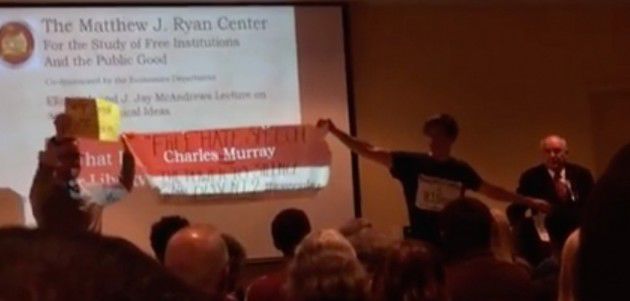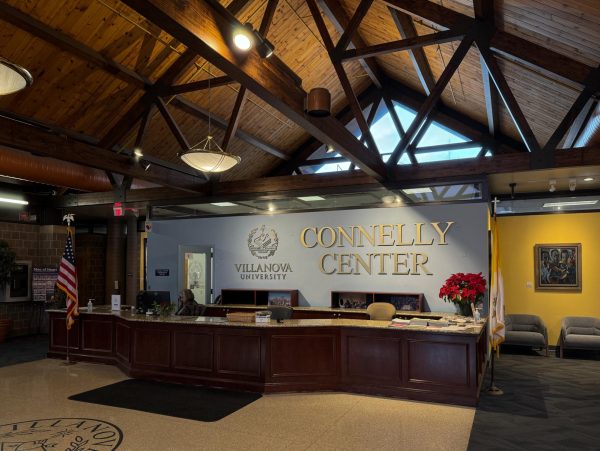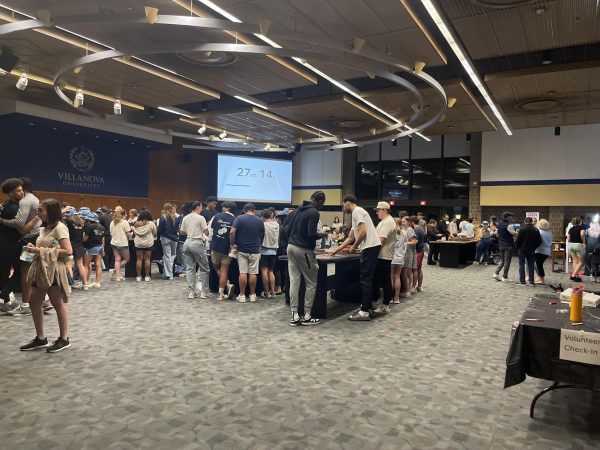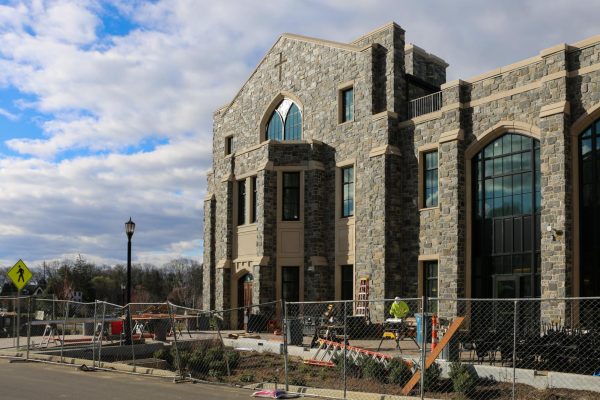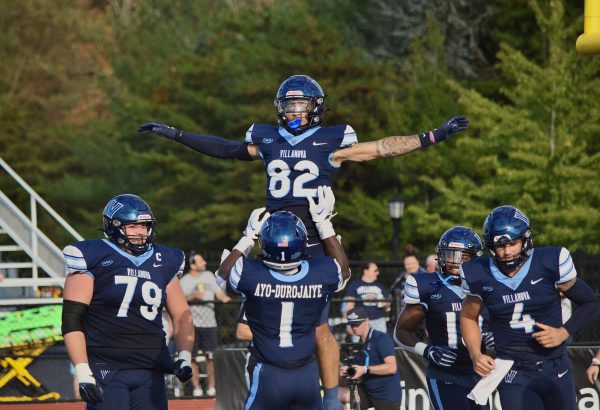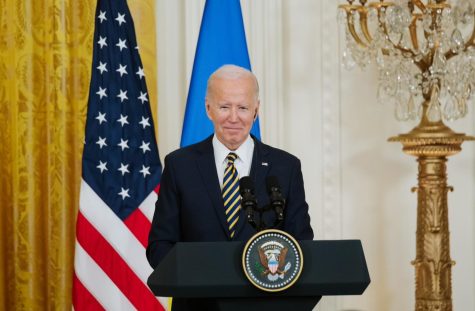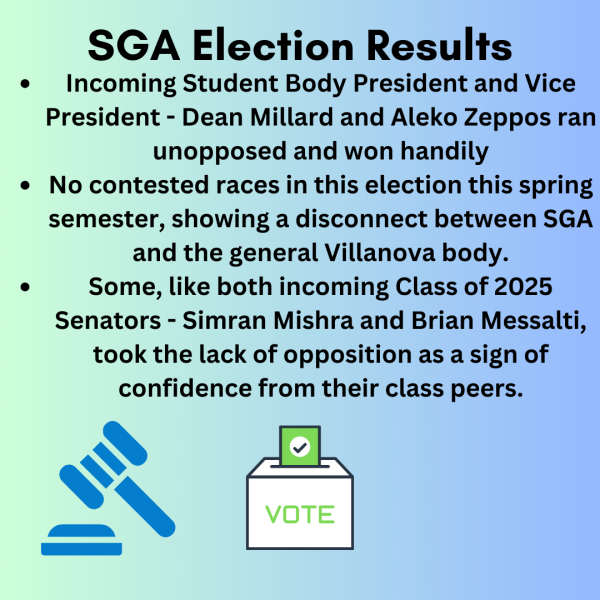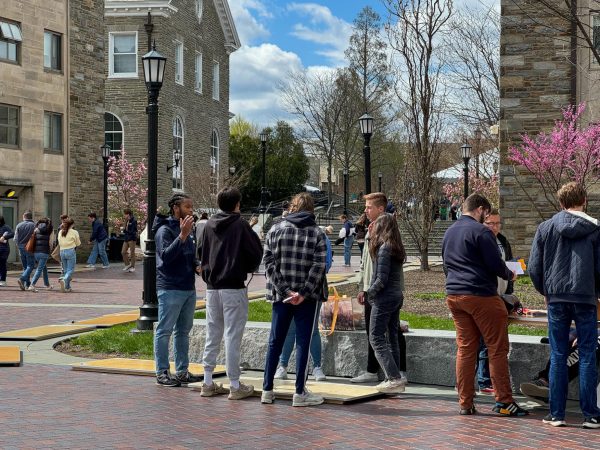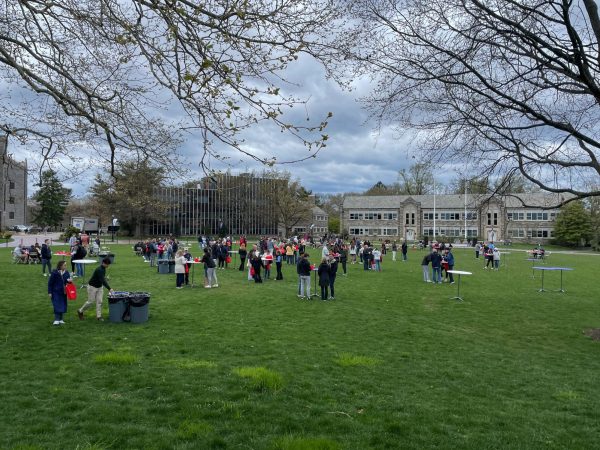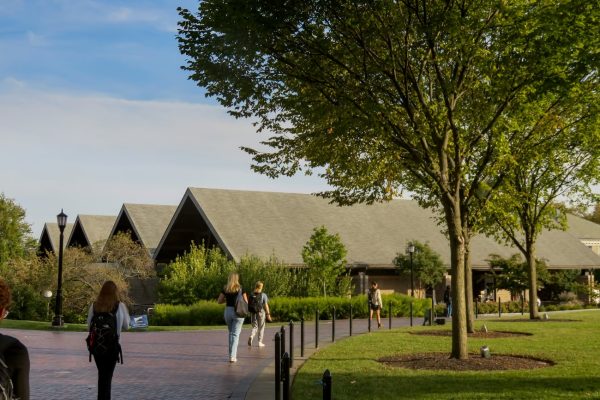Charles Murray Event Draws Unrest
March 31, 2017
The highly anticipated lecture by conservative social scientist Charles Murray drew nearly 200 people to Garey Hall on Thursday afternoon and left several more standing outside. Public Safety officials were forced to begin turning people away 20 minutes before the event began.
As the guest took the podium, a group of protestors, including Associate Professor Gabriel Rockhill, Ph.D. and Adjunct Professor John Patrick Schultz, both of the University’s Philosophy department, stepped to the front of the room. Holding several signs between them, the group chanted over Murray, refusing to allow the lecture to continue. Audience members began to engage with the protestors, and at one point Murray was removed from the room. Fifteen minutes later the group, called “Nova Resistance,” was escorted outside by Public Safety officials, and Murray reclaimed the podium.
“Nova Resistance set out to show this afternoon that Charles Murray has no right to speak at Villanova,” the group said in a later statement. “By inviting Murray – after having rescinded an invitation to a queer activist, whose ‘free speech’ was apparently less important – Villanova offers his ideas the false veneer of respectability. We refuse to be complicit in our silence for the sake of the false niceties of academic conformism, or the fear of powerful economic and political forces framing ‘open debate’ on campus.”
In a later statement the University claimed to promote a strong advocacy for free speech while also encouraging protest. “In the pursuit of education and understanding diverse viewpoints, a wide variety of speakers are invited to campus,” the statement read. “We believe in the right to protest any particular speaker or issue, and expect respectful conduct.”
Disruption of the event made national news later that evening when Fox News host Tucker Carlson showed a clip of the protest.
Hosted by the Matthew J. Ryan Center, Murray was invited to discuss his 2015 publication, “By the People: Rebuilding Liberty Without Permission.” Between interruptions he discussed the federal regulatory state, the 2016 election, and the emergence and social impact of artificial intelligence.
“The regulatory state has grown so far beyond any of its initial constraints that it now regulates behavior that has no visible relationship to right or wrong,” Murray said. “There is no area of American life of which it is now possible to say, this is none of the federal government’s business. And that is radically different from what the intentions of the founders [were], radically different from the way the country assumed it should run for the first couple of hundred years of its existence.”
Audience dissatisfaction continued in several forms throughout the lecture. Earlier protestors could be heard outside, at one point chanting “No Murray, no KKK, no fascist USA” directly into an open window. One individual, later joined by three others, stood silently at the front of the room with a sign reading “Legitimizing racism shames Villanova.”
Audience members continued to stand and interrupt the lecture, one such outburst eliciting discourse about the nature of free speech. Cole Nasta, an undergraduate senior who began to argue that hate speech is legally considered free speech, was spat upon by an audience member leaving the room.
“What happened was the person who felt strongly toward what was happening saw a focal point,” Nasta said after the event. “I don’t think that he had any ill will towards me. I don’t have any ill will towards him. I think he had ill will towards something else. And I was just there to focus on and that was an accident.”
For Alicia Cannon, a sophomore Political Science and Theology double major, certain types of protest were more effective than others.
“Some things [Murray] said were not as problematic as [protestors] were making it because they went in wanting it to be problematic,” Cannon said. “The protestors that were speaking, I thought, were over the top. The one protestor with the sign who just stood there was perfect. He got his point across but he wasn’t rude. There were people who genuinely wanted to learn things, me included…and when people disrupt that, that disrupts my learning.”
As soon as the floor was opened to questions Murray was challenged on his first book, “The Bell Curve,” published in 1994, and the author stated that he is constantly required “to distinguish what we wrote from what people say we wrote.”
“A lot of you in this room think that the topic of “The Bell Curve” was to prove the genetic inferiority of blacks,” Murray said, before reading an excerpt from the book. “What Dick Hernstein and I refused to do was to exclude the possibility of genetic effects. And that’s what all the furor has been about.”
When asked whether he believes everyone in America should be afforded the opportunity to go to college, and furthermore whether that is necessary, Murray said, “I think the B.A is the work of the devil.”.
“What we have done is take a couple of generations of young people and say to them, oh you’ve got to go to college,” Murray continued. “We have not done what we should have been doing, which is to say the goal of education is not to get everybody to college. The goal of education is to have every child grow up having discovered something that he or she likes to do, and having learned how to do it well.” This, according to Murray, can apply to nuclear physics or to skilled labor.
As a Ryan Center representative stepped to the podium in closing, a final protestor rose from the audience. “I’m a senior at Villanova about to graduate with a B.A.,” Kat Gowland said, before applause drowned out her indictment of Murray’s closing statements.
“I am so deeply hurt by the lack of respect that exists within the Villanova ‘community,’” Gowland said later. “The coded language that Murray used to marginalize women and people of color supports a corporate agenda that not only delegitimized the identities of everyone except white males, but also completely rejects the value of my education.”
“What kind of community is this?” Gowland screamed over the din of applause, tears streaming down her face. “Who are you people?”
For Nasta, Gowland’s reaction was more meaningful than the act chosen by the man who spat in his face. “Everything that man just said is terrifying if it’s true,” Nasta said. “And she’s having the appropriate response.”

